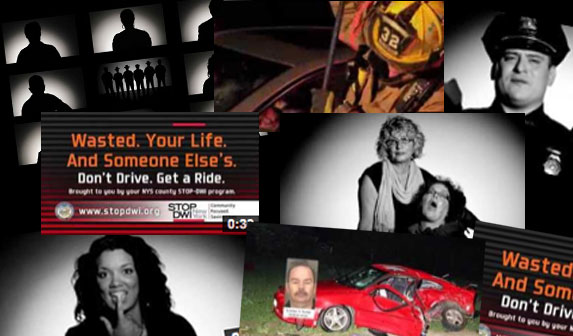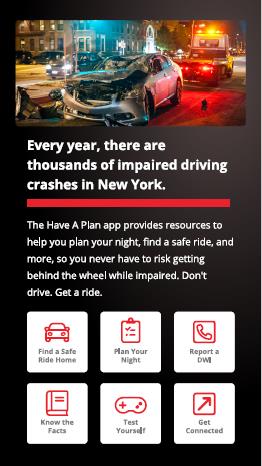New York State STOP-DWI Film Summaries
Friends: An American College Tragedy 13 minutes
The Friends documentary examines the alcohol-related Colgate crash of November 11, 2000 in which four college freshmen died. The film details the easily –made decisions of students during a night out, the life-altering crash and the aftermath that family and friends are left to deal with in their loved ones’ absence. (Oct. 2007)
One Second, Everything Changes 30 minutes
The film highlights a number of crashes involving youth. It examines each crash in an anthropological style, looking at the causes, such as drinking, excessive speed, etc. and the aftermath using first-person accounts of crash survivors, friends, family and law enforcement to illustrate the impact of one person’s wrong choice on families in the community at large. (2008)
The Consequence of No Consequences 15 minutes
The film conveys a parents’ perceptive of the anguish of learning of their son’s death after attending a teenage party. The tragic consequences could have been avoided if he had accepted the ride home from sober driver rather than an impaired classmate. (2009)
The Ripple Effect 13 minutes
The film speaks to the ripple effects on the Kato family after their seventeen year old son was killed by an intoxicated driver in Monroe County. The film also addresses the ripple effect on Shaun Elliot (from high school Principal view) the passenger in Matthew’s vehicle the night he was killed. STOP-DWI Coordinator, Peggy Duffy, a victim herself, provides her perspective of the ripple effect as well. (Oct. 2009)
Living the Code: The Deadly Season 19 minutes
This film explores the choices student athletes make when they commit themselves to living by the athletic code that requires abstinence from alcohol. Matt was planning to go to the Air Force Academy. Tiara was the prom queen and the Lady Wildcat soccer co- captain when she made a decision to go to the after prom party in the woods. Each made choices that had unforeseen consequences. While a repeat drunk driver made a choice that affected Jonathan, a freshman college track star, for the rest of his life. (2010)
The Second Front: Marine Down 13 minutes
The film examines an alcohol related motorcycle crash of passenger Marine Sergeant George Obad in a forensic style. Through interviews with military personnel, it exams portions of military life, including its drinking culture. At the request of the crash victim’s family, the film contains graphic autopsy photos. These photos serve to illustrate the carnage on the highway as the “second front”, underlining the fact that more marines die in crashes at home than have been killed I n Operation Iraqi Freedom. (2009)
The Second Front: Fort Living Room Combat Veterans Stories 17 minutes
In this film decorated combat veterans from Viet Nam, Iraq, and Afghanistan tell how combat stress led to sleeplessness, anxiety and hypervilagence. All used alcohol and became solitary drinkers to quell the symptoms of Post Traumatic Stress Disorder (PTSD). Some became drunk driving felons with arrests in quick succession and went to jail. Will the criminal justice induce secondary trauma or provide a path to treatment for our retuning soldiers when these heroes could be a danger to themselves and others? (2010)
The Second Front: The Roadway Combat Veterans Stories 17 minutes
Post Traumatic Stress Disorder (PTSD) and impaired driving are examined from personal, clinical and ethnographic perspectives. For returning combat veterans the roadway itself is a trigger for PTSD. Combat veterans explain why alcohol is used for self medicating. The symptoms of PTSD are reviewed.-Improvised Explosive Device (IED) survivors tell of their DWI and the need for referral to VA treatment programs. (2011)
The Courage to Serve 17 minutes
This film documents stories of enforcement officials who have been impacted by impaired driving. Their accounts include the effects on their professional and personal lives. (2011)
The Second Front: Vietnam Combat Veterans Stories 26 minutes
This film depicts stories told by Vietnam combat veterans for combat veterans. Each shares one thing in common: the Second Front – the internal battle with Post Traumatic Stress Disorder (PTSD). This can manifest itself as impaired driving on American roads. Upon returning home, these soldiers suffered with the effects of combat trauma in a society where they no longer felt welcomed. Many drank, like the veterans before them, to live day-to-day, for an adrenaline rush, to quell their nightmares. Some also drove drunk, again and again, pushing the limits of safety of themselves and loved ones, pitting themselves against anyone on the road. A few were stopped by police and found the system lenient. After years of living life in extremes, they sought help – and now give help in return.
Post-Traumatic Stress Disorder (PTSD) is the result of direct personal exposure to an extreme stressor, known as combat stress or combat trauma, which develops into characteristic symptoms of re-experience, avoidance and increased arousal. For those combat veterans who suffer from PTSD, the need for safety and relief dominates their actions and choices. Too often self-medication with alcohol and/or drugs is seen as the only option, which can lead to dangerous decisions like driving under the influence. Even in the absence of alcohol and drugs, flashbacks can induce dangerous behaviors like aggressive or erratic driving on American roads. (2012)
Second Front: Mission Change Combat Veterans Stories
One in four combat veterans from Operations Iraqi Freedom and Enduring Freedom suffer from post-traumatic stress disorder or brain trauma. Most veterans recover within six months, however, a significant number do not. They continue to deal with the nightmares, flashbacks, hyper-vigilance, and anxiety on the roadway. Multiple deployments have only exacerbated the situation.
Drunken driving arrests place these heroes into the criminal justice system, which cannot provide the treatment that they need. Society demands that repeat drunk drivers be incarcerated. More returning veterans are being caught in the net of increased drunk and impaired driving enforcement. County jails are becoming holding cells for suffering combat veterans.
This documentary depicts the ordeal of Specialist Andre Leduc of C Company, 1st Brigade, 10th Mountain Division, U.S. Army, Operation Iraqi Freedom. Andre had a clear mission as a medic in the Green Zone, but once he returned home, his mission changed to surviving the Second Front. (2012)
A Cocktail of Prescription Medication: The Crash, Then The Impact 20 minutes
The doctor had prescribed anti-anxiety drugs and Parkinson medications. The middle age woman had five drugs in her system. Three woman hikers were dead and the driver could not remember. No one had told her not to drive. (2013)
Cyclist Down: Sedatives 11 minutes
Mistakenly she had taken an additional dose of her sleeping medication the night before .The driver was in sight of her home when she struck the cyclist. First responders found her disoriented. The cyclist she struck died at the scene. (2013)







